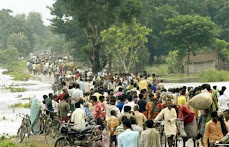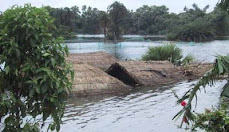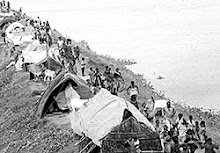Isn't diversion of Ganga, and its tributaries through Interlinking of Rivers project or Kosi High Dam, the biggest threats to the security of Ganga basin?
Almost echoing the words of Dr Dinesh Kumar Mishra, B G Verghese submits that Kosi region "...is possibly being the most blighted part of the entire country The flood has wiped the slate clean. We have a wonderful opportunity to write a completely new script that could put North Bihar in the vanguard of India’s social and economic progress. But none has as yet shown the imagination to do so."
" Repairing the breach in the Kosi’s eastern embankment in Nepal will not guarantee the safety of the 50 year-old Bhimnager barrage" which It has been a long- standing Nepalese grievance that this barrage was built just within its boundary with Bihar and not further upstream, thereby providing Nepal greater flood protection, irrigation and energy benefits. That is history."
But the danger lies in his prescription for engineering solution that is quite contrary to the Ganga basin approach that Prime Minister's Office has announced. Verghese says, " If the Bhimnagar barrage has outlived its lifer, could/should it not be replaced by a new barrage optimally sited further north. Could that also possibly serve as the re-regulating dam for the proposed Kosi High Dam (Barakshetra)-cum-Kurule-Sun Kosi diversion for which a joint detailed project report long under preparation is now to be expedited? In combination, the High Dam and new barrage could help regulate the river and moderate floods, some of the flood being diverted at Kurule into the Sun Kosi and thence beneficially into the water-stressed Kamla basin within Nepal."
He also submits revealing his support for Interlinking of Rivers project saying, "An additional possibility would be diverting some of the Kosi storage eastwards into the Mechi river that marks Nepal’s border with West Bengal. This could in turn augment the flows of the Mahananda and Teesta to resolve an Indo-Bangla argument."
But again he partly and deceptively echoes Dr Mishra, "Further, should the Kosi be fully restored to its pre-August 2008 embanked channel via the Bhimnagar barrage, so as to maintain the existing irrigation system, or should the new eastern arm that has opened up along an old alignment be also kept alive?" but very soon retreats into the make believe worl of structural engineering.
Verghese does not realize the limitations of his suggestions "With some desiltation and training works, this could be converted into the proposed navigation channel to link Nepal to the sea, an aspect of the High Dam study. This second channel could also serve as a flood-reducer by diverting high monsoon flows into yet another channel."
Vergese feels that "The World Bank and ADB would surely assist any credible programme, including dam building, and carbon credits could defray some of the costs."
Despite global financial crisis it is amazing that trust in these institutions remains intact.
Historically, floods and their control have never been a big issue in the Ganga-Brahmaputra basin, as it is today. Floods became a major issue after the British occupied India. When they examined the Ganga basin, they believed that if it could be made “flood-free”, they could levy a tax in return for such protection.
Thursday, 8 January 2009
Subscribe to:
Post Comments (Atom)








No comments:
Post a Comment